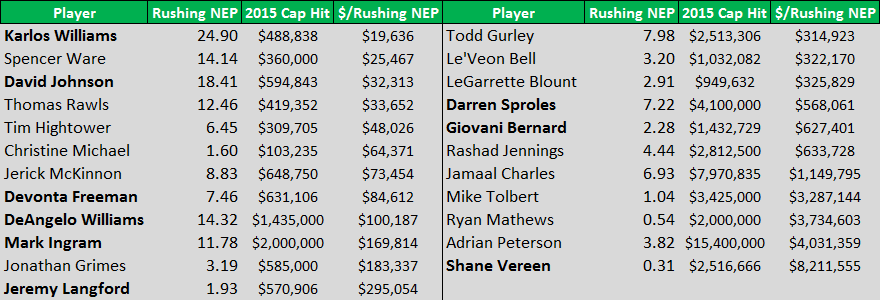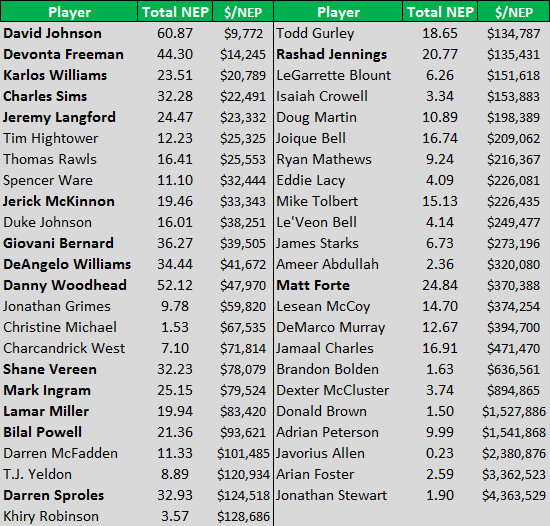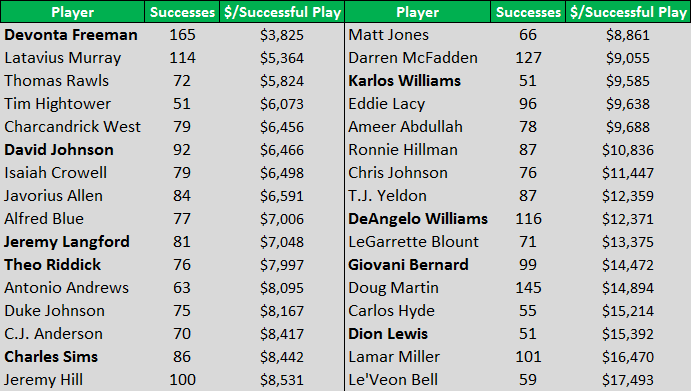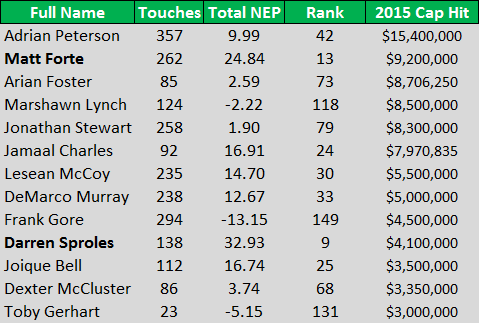The NFL's Most and Least Cost-Effective Running Backs in 2015

The running back position is changing in the NFL.
At the very least, the perception of the position is.
Spending for running backs -- be it in terms of early-round draft capital or bank-breaking contracts -- is becoming a bit old-hat, and when late-round talents like David Johnson and Karlos Williams produce like they did in 2015, it's hard to knock such a philosophy.
That's especially true when realizing how these players -- and other young talents -- produced relative to the salary necessary to roster them.
Which guys provided the most Net Expected Points (NEP) -- or points above expectation -- at a bargain price in 2015? And how did the position's top-earners look?
2015's Most Cost-Effective Running Backs
Just to be clear, earning points above expectation, as measured by NEP, on the ground isn't exactly easy.
Of the 72 running backs with at least 50 carries this year, only 23 posted a Rushing NEP greater than zero. Only a dozen topped 4.50 Rushing NEP.
Dollars per Net Expected Point aren't going to be neat to calculate -- because most players returned negative points on the ground. But here's the breakdown of the 23 players with at least 50 carries and a positive Rushing NEP. (Players who are also in the top 16 in Total NEP are bold, and you can click the table to make it bigger.)
Yup, lots of youngsters on the left -- just like we could have anticipated. However, it was Williams -- not Johnson -- who was the better value. In fact,
Spencer Ware was above Johnson because of his lower cap hit, per Spotrac.
But if we throw in receptions, the group of 50-plus-carry players with positive NEP scores grows from 23 to 47. That's where Johnson steals the show. (Again, the top 16 players by Total NEP are bolded.)
Of course, leading the position in Total NEP helped, but Johnson was a bargain unlike any other.
Devonta Freeman came close (somewhat), and 13 of the top 20 in terms of value were also top 16 players in terms of Total NEP anyway. Big money wasn't necessary for big NEP totals. In fact, it was pretty fruitless this year.
But before we get there, what do we do with the players who struggled to stay on the right side of zero? That is to ask how can we attempt to gauge how the players with negative Total NEP scores rewarded their teams for their salaries?
We can measure this in terms of successful plays provided, which is a sum of the rushes and receptions that led to positive NEP.
Among the 53 backs with at least 50 successful plays, here were the 32 most cost effective per success.
Ah, we knew Freeman had to top a list somehow, given his volume. Sure, he tailed off significantly during the backstretch, but he produced more successful plays (164) than any other back (Adrian Peterson was second at 149). Only 14 backs accounted for at least 100 NEP-boosting plays.
Latavius Murray wound up with a Total NEP of -10.80, which ranked 65th among 72 backs with at least 50 carries last year, but given his volume, he churned out successful plays at a cheap cost. He added NEP on only 34.46 percent of his carries (which ranked 60th in this group), but the volume he saw led to the 8th-highest amount of successful NEP plays at the position.
Perhaps the biggest issue of all is that actually paying top-dollar for running backs was a disaster last season.
If we exclude players who were primarily fullbacks, there were 13 players with a cap hit of at least $3 million. They were #notgood, in terms of NEP.
Blame injury or a lack of passing-game success from these players (because Total NEP gets boosted up by receiving, as it generally leads to more efficient plays than rushing), but the bottom line is that the position's biggest salaries didn't do much last year, relative to their lower-priced counterparts.
Really, it's no wonder that running backs are becoming increasingly problematic when it comes to long-term, expensive contracts.




















